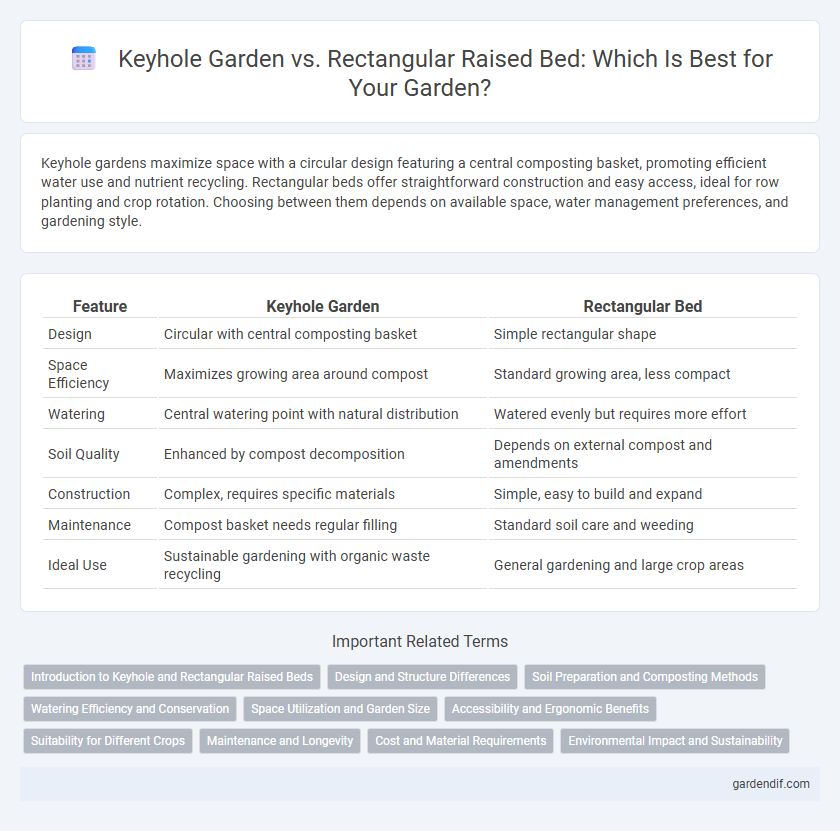
Keyhole garden vs Rectangular bed Illustration
Keyhole gardens maximize space with a circular design featuring a central composting basket, promoting efficient water use and nutrient recycling. Rectangular beds offer straightforward construction and easy access, ideal for row planting and crop rotation. Choosing between them depends on available space, water management preferences, and gardening style.
Table of Comparison
| Feature | Keyhole Garden | Rectangular Bed |
|---|---|---|
| Design | Circular with central composting basket | Simple rectangular shape |
| Space Efficiency | Maximizes growing area around compost | Standard growing area, less compact |
| Watering | Central watering point with natural distribution | Watered evenly but requires more effort |
| Soil Quality | Enhanced by compost decomposition | Depends on external compost and amendments |
| Construction | Complex, requires specific materials | Simple, easy to build and expand |
| Maintenance | Compost basket needs regular filling | Standard soil care and weeding |
| Ideal Use | Sustainable gardening with organic waste recycling | General gardening and large crop areas |
Introduction to Keyhole and Rectangular Raised Beds
Keyhole gardens feature a circular design with a central composting basket, promoting efficient nutrient recycling and water conservation, ideal for small spaces or dry climates. Rectangular raised beds offer a straightforward, space-maximizing layout suited for larger areas, allowing for organized planting and easier access to crops. Both systems improve soil quality and drainage but differ significantly in form and functional benefits.
Design and Structure Differences
Keyhole gardens feature a circular design with a central composting basket, optimizing nutrient distribution and water retention, while rectangular beds have a straightforward linear layout that maximizes planting area and ease of access. The raised structure of keyhole gardens promotes efficient space utilization in limited areas, whereas rectangular beds are scalable and better suited for systematic row planting. Keyhole beds often incorporate natural materials for boundaries, contrasting with the often uniform wooden or metal frames of rectangular beds.
Soil Preparation and Composting Methods
Keyhole gardens utilize a central composting basket that efficiently recycles kitchen scraps directly into nutrient-rich soil, accelerating decomposition and enhancing soil fertility. Rectangular beds require separate compost bins or piles, necessitating more manual effort to incorporate organic matter and evenly distribute nutrients throughout the bed. Soil preparation in keyhole gardens emphasizes layered organic inputs within the bed's design, while rectangular beds depend on thorough soil amendment and tilling before planting.
Watering Efficiency and Conservation
Keyhole gardens maximize watering efficiency by incorporating a central composting basket that delivers moisture directly to plant roots, reducing water runoff and evaporation. Rectangular beds, while easier to scale, often require more frequent watering due to open soil surfaces leading to higher water loss. Compost integration and soil depth in keyhole gardens enhance moisture retention, promoting superior water conservation compared to traditional rectangular raised beds.
Space Utilization and Garden Size
Keyhole gardens maximize space utilization by combining a central composting area with radiating planting beds, allowing efficient access and nutrient recycling in a compact circular design ideal for small garden areas. Rectangular beds provide more linear space, suitable for row planting and larger scale cultivation but can require more area and may have less efficient access to all plants. Choosing between keyhole and rectangular beds depends on available garden size and the need for maximizing growing space versus ease of maintenance.
Accessibility and Ergonomic Benefits
Keyhole gardens offer superior accessibility with their central composting basket and surrounding planting areas, allowing gardeners to reach all parts without bending or stretching excessively, which reduces strain and supports ergonomic health. Rectangular raised beds may require more movement around the perimeter, often demanding bending and stretching that can cause discomfort or fatigue, especially for those with limited mobility. The circular design of keyhole gardens optimizes space and access, making them ideal for gardeners seeking ergonomic benefits and ease of maintenance.
Suitability for Different Crops
Keyhole gardens excel in growing root vegetables, herbs, and leafy greens due to their central composting basket that provides consistent moisture and nutrients. Rectangular beds are versatile and suitable for a wider variety of crops, including larger plants like tomatoes, peppers, and squash, because they offer more space for root expansion and easier access for maintenance. Crop rotation and companion planting are more manageable in rectangular beds, optimizing soil health and productivity for diverse plant types.
Maintenance and Longevity
Keyhole gardens require less frequent watering and are easier to maintain due to their central composting basket that supplies nutrients and moisture efficiently. Rectangular beds often demand more regular watering and weeding, which can increase maintenance time and effort. In terms of longevity, keyhole gardens, constructed with durable materials like stone or brick, tend to last longer without structural degradation compared to wooden rectangular beds prone to rot and decay.
Cost and Material Requirements
Keyhole gardens generally require fewer materials due to their compact, circular design, which reduces the need for extensive wood or metal framing compared to rectangular beds. The cost of constructing a keyhole garden can be lower because it maximizes growing area with minimal space, while rectangular beds often demand more soil, lumber, and reinforcement to maintain structural integrity. Keyhole gardens also typically use organic waste and compost within the central basket to enrich soil, minimizing ongoing material expenses relative to the more material-intensive rectangular bed setups.
Environmental Impact and Sustainability
Keyhole gardens optimize water usage through a central composting basket, reducing waste and promoting nutrient recycling, which enhances soil health sustainably. Rectangular raised beds often require more materials and space, leading to a higher environmental footprint in construction and maintenance. Keyhole designs support biodiversity by encouraging urban composting and minimizing runoff, making them more eco-friendly compared to traditional rectangular beds.
Keyhole garden vs Rectangular bed Infographic

 gardendif.com
gardendif.com